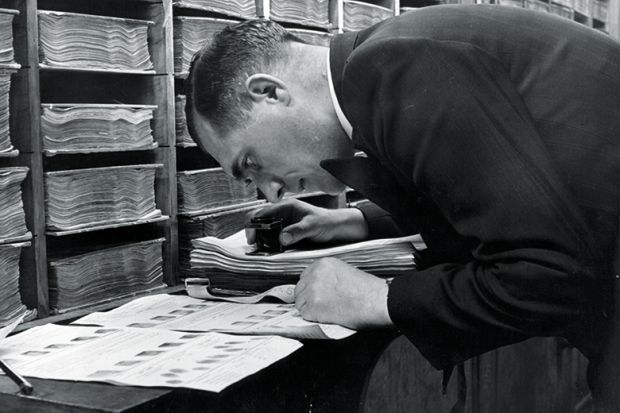A wave of nostalgia swamped me when I started reading The Language of Suspense in Crime Fiction. Suddenly, I was 18 again and staring at a book on discourse analysis that might as well have been in Etruscan for all the sense it made to me. Studying English at secondary school just hadn’t prepared me for this.
Thirty years on, I wasn’t half glad of that University of Birmingham language training, which gave me a fighting chance of following Reshmi Dutta-Flanders’ avalanche of coding and terminology. It is subtitled “a linguistic stylistic approach” and, if ever a book needed a glossary, this is it. Casual genre enthusiasts often read books aimed primarily at the academy, as the non-fiction category in various awards will testify, but I suspect that all they will take away from this one is that plotting in crime fiction doesn’t proceed in a linear manner; that some books are whydunnits, not whodunnits (my terms, not Dutta-Flanders’); and that there are unreliable narrators around – one of the texts analysed in some detail is Agatha Christie’s The Murder of Roger Ackroyd.
It’s often hard to prise out exactly how and where she’s grappling with the overall mechanics of the plots – she’s much more concerned with dissecting and diagramming phrases and key words. It’s all very clinical and never captures the energy and vigour of a juicy genre plot. I also couldn’t help wishing for some clearer signposting along the way in the form of conclusions to chapters (and a meatier final conclusion) to enable the hard-pressed reader to follow the analysis.
Dutta-Flanders also considers P. D. James’ Cover Her Face, Ford Madox Ford’s The Good Soldier, Ira Levin’s A Kiss Before Dying, Patricia Highsmith’s The Talented Mr Ripley, Ruth Rendell’s A Demon in My View and Graham Greene’s A Gun for Sale. I list all the books because I raised an eyebrow at her choices. You won’t, though, find a justification for them – which is unfortunate, given that there’s a heavy bias towards older books (Ruth Rendell is the most recent, and that’s a 1976 text). The Good Soldier isn’t a traditional presence in the crime fiction canon – and I’d really like to know why it’s there.
Maybe it’s time for academics scrutinising crime fiction to be as aware of what’s happening now in a fast-moving genre as of what was done in days gone by. Recent books by the likes of Marcel Danesi and Luc Boltanski, both mentioned by Dutta-Flanders, often make little reference to modern conventions. Which is a tad surprising: things have moved on apace from Agatha Christie! I refer you back to my Birmingham days when we were firmly talked out of doing a final-year dissertation unless we had an earth-shattering area to explore. “The world doesn’t need yet another study of E. M. Forster,” said a weary-eyed lecturer.
Don’t think for one moment that I’m advocating ignoring the classic texts – to see where we are now, we have to appreciate where we’ve been. But there’s a plethora of energetic new material out there just crying out to be analysed. A quick glimpse at conference schedules will confirm the breadth and depth of literary research at academic grassroots level. And we also have the literary stylistics, forensic semiotics and criminology crew all keen for a piece of the action.
A couple of jobs back, I wrote and delivered a module, as part of a journalism degree, on the journalist in film and fiction. The movie classics included Citizen Kane and All The President’s Men. A working lifetime of ferreting out books featuring journalists suddenly paid off big-time. New Grub Street was included for the historical context, as was Scoop (I always fancied a cleft stick and a collapsible canoe). Gonzo journalism was there in the form of Hunter S. Thompson (and I then spent the next two years smiling long-sufferingly as students tried to persuade me they’d got something new to say in dissertations on the topic). But, joy of joys, there was all that shiny crime fiction featuring journalists, some of it feeling like it had leaped off newspaper front pages…
When you think about it, journalists make logical investigators, as they’ve got a reason to poke their noses into crimes. So we looked at Denise Mina’s fabulous – and sadly unfinished – series featuring young Glaswegian reporter Paddy Meehan (those books nailed 1980s newspapers perfectly), John Morgan Wilson’s bleak series starring disgraced gay journalist Benjamin Justice and the thrillers of Dan Fesperman, who plonks his often dysfunctional hack heroes in the trouble spots of Eastern Europe and Afghanistan. And, naturally, Stieg Larsson’s The Girl With the Dragon Tattoo was there – one year I reckon I marked 20 essays (the students could choose their own research areas) on the trilogy. A bemused student read Colin Forbes’ quaint thrillers, which feature a gentleman foreign correspondent, and commented with great understatement: “The journalist bloke doesn’t write much, does he?”
What I’m saying is that crime fiction is an eclectic genre bursting with rude health. If I were a language specialist, I’d look at Ken Bruen’s sparse prose as he bends the private investigator genre into broken, melodic places with his Galway-based Jack Taylor series. I’d trace Scottish writers through William McIlvanney, the godfather of Tartan Noir, whose characters sound like they breakfast on iron filings, to Ian Rankin and Denise Mina. I’d want to examine the patois and street talk of Dreda Say Mitchell’s debut Running Hot – sadly toned down considerably when she moved to a mainstream publisher.
The serial killer never goes away, but an unwelcome presence is what might be called “torture porn”. A lot of it is as nauseating as it sounds. And then we have dozens of prologues – enigmatic introductory sections that tend to be instantly forgettable and often only make a smidgen of sense as one reads on. I’d also take a look at the Americanisation of UK English in crime novels, often perpetrated by writers who seem to have a wistful eye on a film deal. Unreliable narrators we can do you by the lorryload – we know they’ve been around since dinosaurs walked the earth, but at the moment they’re likely to be seemingly paranoid women, often with a dodgy hubby and brattish kids in tow. Both Gone Girl and The Girl on the Train have a lot to answer for.
Those are some of the topics, largely neglected by Dutta-Flanders, that I’d like to see academic studies of crime fiction taking on. Now excuse me, I have the new Ken Bruen to read.
Sharon Wheeler is a visiting lecturer in media and communication at Coventry University, author of Feature Writing for Journalists and co-editor of www.crimereview.co.uk.
The Language of Suspense in Crime Fiction: A Linguistic Stylistic Approach
By Reshmi Dutta-Flanders
Palgrave, 500pp, £60.00 and £47.99 (e-book)
ISBN 9781137470270 and 0287 (e-book)
Published 23 May 2017

The author
Reshmi Dutta-Flanders, honorary research fellow in English language and linguistics at the University of Kent, was born in Kolkata, India and studied English literature as an undergraduate. She came to England in 1985 and studied Old English at King’s College London, but “soon realised [she] wanted to study literature through language”.
After completing an MA in English language in literary studies at the University of Nottingham, Dutta-Flanders was eager to use her new skills in a PhD, and it was suggested that she might investigate crime fiction. Having earned a doctorate from Kent, she worked in prison education for eight years.
“I worked in youth offender and adult prisons,” she recalls, “and I taught many blue-collar prisoners, youth offenders and sex offenders alike. [Having had] limited experience in the prison sector at the time, I could say on reflection that I grew up alongside the prisoners as a tutor, became a trainer, and then a mentor.
“It was my impression that for long-term prisoners, tutors were the connecting link to the world outside. [They] intrigued me. I felt there was always something I was not being told…which made me wonder about how genuine they were as they appeared to me in the classroom, especially in the light of reoffending.”
Yet Dutta-Flanders remained keen to return to teaching linguistics. “When the English language and linguistics department reopened at Kent, I applied as an assistant lecturer. This was my opportunity to get started with research into offender stories (the factual in the light of fiction) and take up the opportunity to bring together my background in crime fiction with my experience in teaching in prisons. Hence, my recent book on the language of suspense is offender-focused, and explores the offending process from fictionality to factuality and vice versa.”
Matthew Reisz
后记
Print headline: Decoding the detective novel
